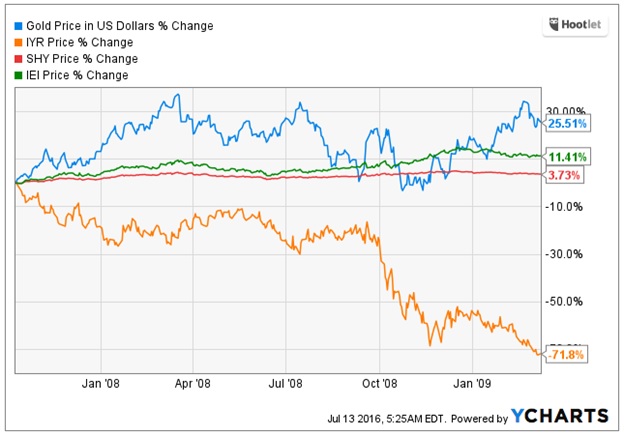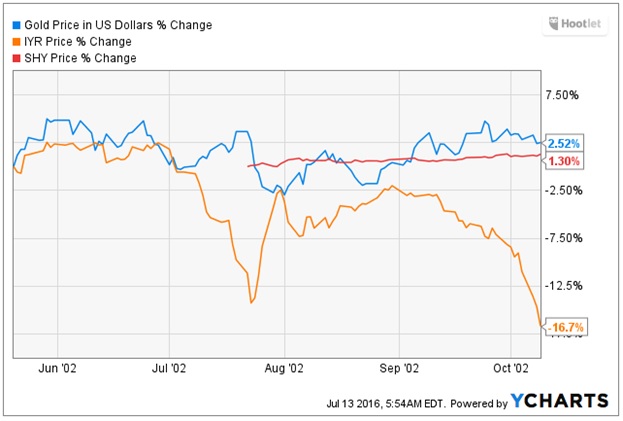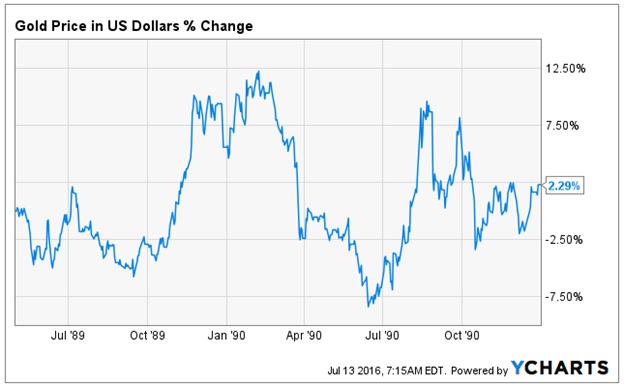A Comparative Analysis Of Gold, Bonds And Real Estate In Times Of Economic Turmoil


Financial crises have become a regular occurrence in the history of the US economic landscape. Economists, financial analysts and policymakers agree that the complex nature of the economic landscape increases the likelihood that things will be messed up at a point in time. The occasional regulatory oversight, poor accounting and herd mentalities often bedevil the US economic landscape. Consequently, the financial history is dotted with exuberant highs and heart-wrenching lows.
In the last 100 years, the US economic scene has experienced 20 recessions – you can call it financial meltdown or economic crisis and you'll still be saying the same thing. The US has suffered an average of one recession every five years in the last 100 years. Interestingly, during times of economic turmoil, people tend to load up investments in low-risk, stable, relatively secure assets.
In times of economic hardship, precious metals such as gold, bonds, and real estate tend to become the most popular investment vehicles in the market. However, smart investors don't just follow the herd in making investment decisions. Smart investors don’t buy assets because they are popular; they buy an asset because they understand its risks and they are comfortable with its risk reward ratio. This article seeks to compare and contrast the performance of gold, bonds and property during some of the recent periods of financial crises.
Global Financial Crisis – 2007 to 2008
The global financial crisis that rocked the world from 2007 through 2008/2009 is still fresh in our minds. Therefore, it won't be necessary to go into the history of the events that led to the financial crisis. Nonetheless, it is important to point out the fact that the financial crisis of 2007 triggered a 17-month stocks bear market that lasted from October 9, 2007 to March 9, 2009. The effects of the global financial crisis were felt throughout the world and record of inflows and outflows of funds at sendmoneyaustralia.com revealed a huge drop in currency flow across international borders.
The bear market was severe such that the Dow Jones Industrial Average crashed by 20% in a single session, while the S&P500 lost about 50% of its value during the entire bear market period. The huge decline recorded in stocks forced investors into traditionally safe investments such as gold, bonds and real estate. The chart below shows the performance of gold, bonds and real estate during the 2007/2008 global financial crisis.

From the chart above, you'll see gold (Blue line) recording gained 25.51%, while the financial crisis lasted; understandably, some investors booked bigger gains when the yellow metal touched its high points. Bonds also delivered decent returns during the financial crisis. For instance, the iShares 1-3 Year Treasury Bond (SHY) (Green line) was up 11.41% during the crisis. More so, the iShares Barclays 3-7 Year Treasury Bond (IEI) (Red line) managed to record 3.73% gains during the crisis.
Interestingly, real estate went bust during the crisis and many investors lost money even though the properties that they bought were intact. The iShares Dow Jones US Real Estate (IYR) (Orange line) crashed by as much as 71.8% while the economic crisis lasted.
The Dotcom Crash – 2000 to 2002
Investors won't forget the Dotcom crash that happened between 1999 and 2002 – the crash was severe between March 11, 2000 and October 9, 2002. A quick reminder on the crash; it all started with commercial availability of the Internet in 1995. Soon enough, investors fell in love with the IPOs of internet companies in the hopes of buying into the next Microsoft. Investors were blindfolded by the promises of a "new global economy". Consequently, many of them bought shares without taking as much as a glance at the business plans of those internet companies.
The ensuing dotcom crash was catastrophic as the Nasdaq Composite lost 78% of its value at the bottom of the crash. As expected, investors rushed out of internet companies to seek refuge in traditionally safe investments. The chart below shows the performance of gold, bonds and real estate during the financial crisis.

During the dotcom crash, Internet companies were going bust and their founders and investors were going broke. However, gold investors managed to record decent 2.52% gains (Blue line). Bond investors also managed to score some gains as the iShares Dow Jones US Real Estate (IYR) (Red line) scored 1.30% gains. Real estate investors were trashed because of the Silicon Valley millionaires were selling million-dollar estates to move into the basements in their parents' houses. The iShares Dow Jones US Real Estate (IYR) (Orange line lost 16.7% while the dotcom crash lasted.
Junk Bond Crash – 1989
Not many people will remember the events that led to the Junk bond crash that lasted from 1989 to 1990. However, the Junk bond crash is one of the lowest points in the economic history of the United States. The US bond market had one of its biggest growth periods between 1980 and 1989, when it jumped from $10B to $189B. The exponential growth in bonds led to the proliferation of junk bonds; however, the fact the bonds were delivering an impressive performance didn’t give investors much reasons to be worried about the junk bonds.
However, Rudolph Giulianu’s political movement of 1989 and other factors led to a temporary collapse of the bond market. The collapse of the bond market triggered the bankruptcy of Drexel Burnham. Moreover, it wasn’t long before many of the new junk bonds evaporated from the market. The chart below shows the performance of gold during the junk bond crash.

The chart above shows the performance of gold between May 1, 1989 and December 31, 1990. Gold was smitten by a high level of volatility marked by impressive highs and deep lows; nonetheless, the bullion managed to score 2.29% gains. However, it is obvious that a crash in the bond market often leads to increased volatility for gold. Subsequently, investors might do better to stay on the sidelines when there's a crash in bonds.
Final Words
History tends to repeat itself. Even when it doesn’t show a duplicative repeat, it tends to show a rhyme. The aforementioned cases of financial turmoil in the US economic discourse have shown the degree of volatility, gains and returns that different assets classes offer to investors.
The US is on the brink of another economic crisis. To be sure we are long overdue for an economic crash, where investments will perform in the same way that they have always performed during periods of financial turmoil. However, you can take valuable insight from the information provided in this article to mark smart investments to protect yourself in the event of the inevitable financial crises.
********
Free Gold-Eagle Newsletter!
- Fresh weekly insights on gold, precious metals, and the economy
- Leading authors from around the world
- Always free
- Stay informed!
















